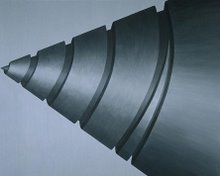
The Brightest Thing in the World
A portrait of visionary naturalist W.N.P. Barbellion & tribute to historian and teacher George Roeder
by Matthew Goulish
Part 2.3 ('What We See')
We drove home after rehearsal on an afternoon in spring. Our route from the Wellington Avenue Church gym took us down Racine Street, onto which we had just turned south off of Oakdale, when we saw George walking with a friend. We waved hello, and he rushed up to the car. We stopped, and he leaned on the open passenger window, and said he had something important he needed to tell us. What luck we met. He was just walking in the neighborhood after a baseball game at Wrigley Field. Anyway, a few weeks before he had attended a performance of our piece The Sea & Poison, and while watching it, he said, a profound idea had occurred to him. It had happened at the moment that I planted a seed on my head. He began detailing the revelation - how he felt it's first rumblings as I poured the dirt. Then I inserted the seed, and he had suddenly visualized the image of a sheer rock cliff face. I sprinkled the water, held up a lamp, and started playing a little music, and at that moment he had grasped the full importance of the thought he was having. In the quiet moments that followed in the performance, as I waited for the seed to grow, he had fully formulated his idea, which he now had to tell us. Suddenly a car horn blared, and the three of us - Lin in the passenger seat, George leaning in her window, me in the driver's seat - realized a small line of traffic had piled up behind us where we had stopped. Go ahead, said George, pointing to the light at the intersection one block ahead at Diversey. That light is green now, he said, but by the time you get there it will be red, and I'll catch you there. We drove on, and in the rearview mirror I glimpsed George sprinting behind us. I let the impatient cars pass, and stopped at the light as it turned yellow. In a moment, George had caught up to us. He leaned on the window again, now mightily breathless, and finished his story. I'll make this short and tell it before the light changes. A sheer rock cliff face - some look at it and see striations and the geological history of the earth, others see birds of prey nesting in the crevices, still others see mosses and plants that grow there under those conditions. Anyway, what we see when we look at anything, a cliff face is just an example, it could be anything really, what we see depends entirely on what we know, and I realized I can formulate a new course based on this idea. I will call it What We See, and in each class we will all look at the same thing and study how we see something different based on what we know. We will have for example three visitors: a painter, a geologist, and a historian; all looking at the same thing and describing the differences in what they see. That's the idea, and it all came to me when you planted the seed on your head. So thank you. The light's green. See you soon. He leapt back onto the sidewalk and waved, and the insistence of traffic behind us forced us to drive on. I wrote this on the day of George's wake. His obituary appeared in the morning's Chicago Tribune: 'Admired professor at Art Institute school', it called him. It mentioned his research into the censored photos of World War II, and his habit of remembering telephone numbers by connecting them to the dates of historical events. Of all the pictures of him that I carry in my head, in the one of which I am most fond, he is sprinting in the rearview mirror. He will catch us at the red light, and there he will finish his story.






No comments:
Post a Comment